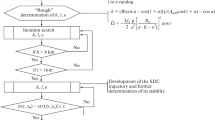Abstract
The role of materials in the development of spacecraft for disposal of space debris is considered. The necessity of taking into account the induced time-varying resistivity of different materials is shown, since the destruction of structural elements occurs under the combined action of the load and the environment that occur on the surface and in the volume of the structural elements under study.




Similar content being viewed by others
REFERENCES
Liou, J.C., Matney, M., Anz-Meador, P., Kessler, D.J., Jansen, M., and Theall, J.R., The new NASA orbital debris engineering model ORDEM2000, NASA/TP-2002-210780, S-890, NAS 1.60:210780, 2002, p. 98.
Taylor, M.W., Orbital Debris: Technical and Legal Issues and Solutions, Montreal: Institute of Air and Space Law, 2006.
Aleshin, V.I., Astrakhantsev, M.V., and Afanas’eva, T.I., Monitoring tekhnogennogo zasoreniya okolozemnogo prostranstva i preduprezhdenie ob opasnykh situatsiyakh, sozdavaemykh kosmicheskim musorom (Monitoring of Anthropogenic Pollution of Near-Earth Space and Warning of Hazardous Situations Induced by Space Debris), Makarova, Yu.N., Ed., Moscow: TsNIIMash, 2015.
Lavrent’ev, V.G., Oleinikov, I.I., and Chervonov, A.M., Main aspects of anthropogenic situation monitoring in near-earth space for guaranteeing cosmic activities security, Mekh., Upr. Inf., 2015, vol. 7, no. 1, pp. 216–228.
Makarov, Yu.V., Space debris monitoring: Problems and solutions, Nanoindustriya, 2019, vol. 12, no. 1, pp. 6–14. https://doi.org/10.22184/1993-8578.2019.12.1.6.14
Nikol’skii, V.V., Proektirovanie kosmicheskikh apparatov (Design of Space Vehicles), St. Petersburg: Baltiiskii Gos. Tekh. Univ., 2003.
Vanke, V.A., Microwave-electronics—Of prospect in space power, Tekhnol. Konstruirovanie Elektron. Apparature, 2007, no. 6, pp. 12–15.
Egorov, A.G. and Tizilov, A.S., Prospects and problems of movement and power plants in powder metal fuel, Vestn. Samar. Gos. Aerokosmicheskogo Univ., 2011, nos. 3–2, pp. 277–281.
Barkova, M.E., Kuznetsova, V.O., Zhukov, A.O., and Kartsan, I.N., Management of processes of space debris capture and processing into fuel, J. Phys.: Conf. Ser., 2021, vol. 1889, no. 4, p. 042086. https://doi.org/10.1088/1742-6596/1889/4/042086
Kuznetsova, V., Barkova, M., Zhukov, A., and Kartsan, I., Analysis and assessment of the effects of corrosive hydrogen media on the stress-strain state of a spherical titanium alloy shell, Mater. Sci. Forum, 2022, vol. 1049, pp. 85–95. https://doi.org/10.4028/www.scientific.net/msf.1049.85
Popov, V.G. and Yaroslavtsev, N.L., Zhidkostnye raketnye dvigateli (Liquid Fuel Rocket Engines), Moscow: MATI, 2001.
Tret’yakova, S.G., Rastunova, I.L., and Rozenkevich, M.B., Studying the possibility of usage of the Sabatier reaction as a way to reverse the flows for isotope exchange in the carbon dioxide-water system, Usp. Khim. Khim. Tekhnol., 2008, no. 8, pp. 70–75.
Hao, J.-C., Leng, J.-S., and Wei, Z., Non-destructive evaluation of composite pressure vessel by using FBG sensors, Chin. J. Aeronaut., 2007, vol. 20, no. 2, pp. 120–123. https://doi.org/10.1016/s1000-9361(07)60017-x
Blassiau, S., Bunsell, A.R., and Thionnet, A., Damage accumulation processes and life prediction in unidirectional composites, Proc. R. Soc. A: Math., Phys. Eng. Sci., 2007, vol. 463, no. 2080, pp. 1135–1152. https://doi.org/10.1098/rspa.2007.1817
Vinogradov, A., Danyuk, A.V., Merson, D.L., and Yasnikov, I.S., Probing elementary dislocation mechanisms of local plastic deformation by the advanced acoustic emission technique, Scr. Mater., 2018, vol. 151, pp. 53–56. https://doi.org/10.1016/j.scriptamat.2018.03.036
Seow, C.E., Zhang, J., Coules, H.E., Wu, G., Jones, C., Ding, J., and Williams, S., Effect of crack-like defects on the fracture behaviour of wire + arc additively manufactured nickel-base Alloy 718, Addit. Manuf., 2020, vol. 36, no. 12, p. 101578. https://doi.org/10.1016/j.addma.2020.101578
Grazion, S., Spiryagin, V., Erofeev, M., Kravchenko, I., Kuznetsov, Yu., Mukomela, M., Velichko, S., Ašonja, A., and Kalashnikova, L., Diagnostics of defect detection in the initial stages of structural failure using the acoustic emission method of control, Appl. Eng. Lett., 2022, vol. 7, no. 2, pp. 45–53. https://doi.org/10.18485/aeletters.2022.7.2.1
Gorbachev, V.I. and Kabanova, L.A., Formulation of problems in the general Kirchhoff-Love theory of inhomogeneous anisotropic plates, Moscow Univ. Mech. Bull., 2018, vol. 73, no. 3, pp. 60–66. https://doi.org/10.3103/S0027133018020020
Zubov, L.M., Von Kármán equations for an elastic plate with dislocations and disclinations, Dokl. Phys., 2007, vol. 52, no. 1, pp. 67–70. https://doi.org/10.1134/S102833580701017X
Petrov, V.V., Ovchinnikov, I.G., and Inozemtsev, V.K., Two-step method of sequential perturbation of parameters and its application to solution of nonlinear problems of solid mechanics, Problemy prochnosti elementov konstruktsii pod deistviem nagruzok i rabochikh sred (Problems of Strength of Structural Elements under Action of Loads and Working Media), Saratov: Saratovsk. Gos. Tekh. Univ., 2001, p. 6.
Treschev, A.A. and Spasskaya, M.V., Stress-strain state circular cylindrical shell made of materials with complicated properties, Mater. Phys. Mech., 2016, vol. 29, no. 1, pp. 32–38.
Author information
Authors and Affiliations
Corresponding author
Ethics declarations
The authors declare that they have no conflicts of interest.
Additional information
Translated by A. Kolemesin
About this article
Cite this article
Barkova, M.E., Zhukov, A.O., Kartsan, I.N. et al. A Robotic Collector of Space Debris. J. Mach. Manuf. Reliab. 52, 411–421 (2023). https://doi.org/10.3103/S1052618823050035
Received:
Revised:
Accepted:
Published:
Issue Date:
DOI: https://doi.org/10.3103/S1052618823050035




